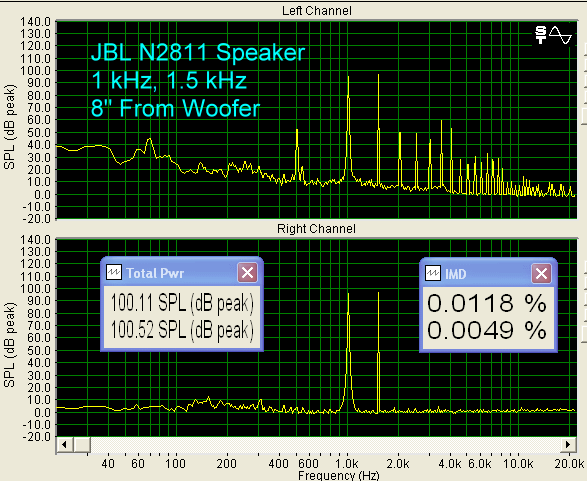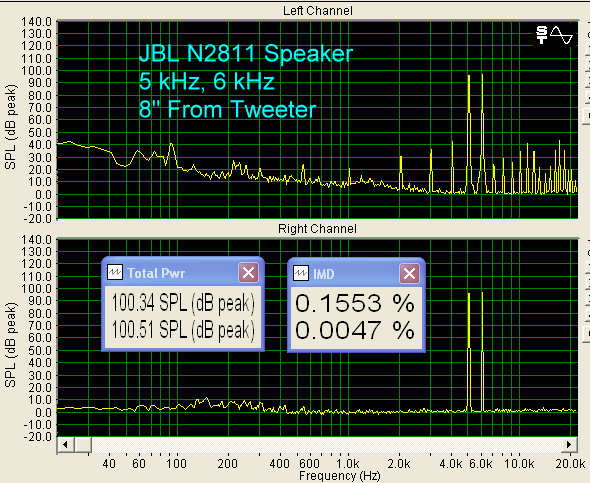Introduction
Bookshelf speakers have always been a part of my
life either out of necessity, or simply because I am intrigued by the great
sound from a small package. I have owned a lot of different small speakers,
enough to know that the term “Bookshelf” is often a misnomer.
The JBL Northridge series of speakers is intended to combine the
technical performance of JBL studio monitors, at a price point that is
within reach of most consumers.
The whole Northridge line has been updated to the series II which makes
use of new driver construction. The woofers and midrange drivers are made
from the most recent formulation of JBL's PolyPlas™ polymer coated cellulose
fiber. This material is intended to provide the sonic neutrality of paper
with the added rigidity of the PolyPlas treatment. The combination is
intended to give smooth frequency response, with faster transient response,
and higher playback levels without distortion. These drivers also use JBL's
HeatScape™ motor structure, which improves heat dissipation for accurate
performance even during high-volume playback.
The Northridge series uses the same ¾” titanium-laminate-dome tweeter. The
tweeters operate using a proprietary waveguide that JBL calls the
“Elliptical Oblate Spheroidal™ or EOS™ waveguide. This waveguide is
intended to direct sound toward the listening area and away from the side
walls for better imaging and a wider sound field. The EOS waveguide is
designed to deliver the same response off-axis as it does on-axis.
The Bones
The Northridge N28II is not a small speaker, being 20” tall and weighing
more than 20 pounds. It is the top end of the Bookshelf Range in the
Northridge line. The N28II uses the same ¾” tweeter as the rest of the line
and an 8” mid-woofer. It is crossed over at 4 kHz and uses a flared port
to help boost bass frequencies.
The cabinet is a “High Strength, High Density wood enclosure that is
braced and damped for minimal vibration”. Simply put, it passes the knock
test ok. It is not like smacking a battleship, but it is a decent effort.
The cabinet has a black ash vinyl finish that is well done, and it is equipped
with good quality five-way binding posts.
The N28II's drivers are video shielded so placement will not affect your
TV. The N28II looks very clean and simple with the grille in place. With the
grille off, this speaker has a distinctly techno look with the grey tweeters
against the black ash finish.
Multi-Channel Sound
I listened to the N28II's for three weeks in both my living room system
and in our theater. Fresh out of the box they went into the L&R front
positions in our home theater. I turned on a TV channel, shut down the
projector, and let them run for a few days to break them in. I was not sure if break in
was necessary, but I did it anyway.
My current theater speakers use silk dome tweeters rather than metal. It
was a noticeable difference at first. The N28IIs were not necessarily
brighter because of the tweeters; they simply were not as lush as the house
brand. The difference is understandable, and expected. The Cost of the N28II
pair is about a third of the cost of the individual speakers in our surround
system, and metal does sound different than silk. It is a preference thing
though, not that one is necessarily better than the other.
I was surprised at how well the N28II's blended in with the other
speakers in my seven-channel system. With the N28IIs in the same positions as
our regular Left and Rights, imaging was very good. Mid and high end detail
were precise, and the speakers handled dynamic material without a problem.
The whole system was crossed over at 80 Hz for both movies and music. I
watched the Godfather series over a three day period, and the fabulous score of
these films was delivered carefully with good imaging and
localization. Listening levels were maintained in the range of 65 to 85 dB,
and there was no indication that the N28IIs were even challenged at this
output level.
Next up were the two Terminator films. If the Godfather films are the
equivalent of a classic American opera, then the Terminator films are the
classic American rock concert. These films are best enjoyed with the volume
up. I took this opportunity to push these speakers around a bit and see if
they were truly the offspring of JBL's Pro Audio line. The listening levels
were in the 85 to 105 dB range, and the N28IIs were able to deliver good
imaging without appearing to be weak points in the front array.
While it was apparent that my usual speakers were missing from their
normal left and right duty stations, the N28IIs were not disappointing
substitutes. It was obvious during the motorcycle chase scene in T2,
as the exhaust tone of Arnold's Harley panned back and forth across the
screen, that there were different speakers on the left and right than in the
center. In this situation it is important to keep in mind that I was quite
focused on the speakers. These are films that I am very familiar with and
they have tremendously busy scenes that would not usually draw attention to
this sort of subtle difference in sound. It also points out the necessity of
staying with the same brand and models across the front, when possible.
A surround system making use of five or six N28IIs combined with a
subwoofer would make a very capable theater audio system. The N28II's did a
yeoman's job in the theater for the rest of the week. They were fed a steady
diet of typical family programming without anyone else even noticing that there
was a new set of speakers in the room. Once I took the grilles off, they
finally noticed the different look of the silver trim panels and it was
pointed out that “We had some cool new speakers” in the media room. I would
say that comment was an affirmation of the target market for the styling of
this product.
I did experiment with running these speakers without a center channel,
and then without the surrounds, while still watching images on the display.
The N28IIs with only a subwoofer added produced a respectable soundstage, and
were able to properly locate dialogue on our 92” x 52” screen without
drawing attention to themselves. This would support the design concept of
the EOS™ waveguide. I am an engineer, and I had to look up the word "Oblate",
which by the way means flattened or depressed at the poles.
Two-Channel Audio
The next stop for N28IIs was the living room and onto a pair of 30” tall
Target stands. If you choose to use speakers this size on stands it is
really important to secure them. If they fell on a child, or on your foot
for that matter, it would be unpleasant. The family cat or small dog would
not appreciate it either.
Run as a stereo pair full range, these speakers were capable and accurate
performers. Bass-heavy material above 80 dB challenged the N28IIs which
makes sense for a mid-level bookshelf speaker. These are not your father's
“Rap Master Daddy” speakers, but then neither are most of the other speakers
this size, or at this price point. If you want big bass, then you will have
to pair them with a sub.
I started out with Buddy Guy's spirited live recording “The Real Deal”.
Buddy is backed by G.E. Smith and the band from Saturday Night Live. This is
the sort of material that the N28II handles well. The music is showcasing
the fantastic guitar work of one of the very best blues guitar players of
our era. The N28II's handled this music with aplomb. It was fun to push them
to sound levels that were quite high, without distorting the message that
was speaking from Buddy's guitar.
Then came "Seven Come Eleven" from the Lionel Hampton and Friends Telarc CD.
The vibes are one of my favorite instruments. On this recording they are
being touched by the one person most responsible for my attraction to this
instrument. I was expecting to find flaws with the N28II's here. I thought the velvety
smooth sound of the vibraphone was going to have some edge to it, some of
the cream skimmed off. Surprisingly, while the N28 seemed a bit bright, it
was not the first thing that I noticed when the song began to play. The
vibes were sounding just fine, and I wound up listening to the whole disc.
Erykah Badu's debut CD "Baduisim" was the last challenge for the JBLs.
This is a taxing low end piece for most systems. Erykah's honey sweet voice
was no problem for the N28IIs. She sounded clear and articulate, her voice
taunting and scolding. But, the weak point of this speaker was finally showing
itself. The bottom end was simply too much low end information for this
speaker to reproduce at significant sound levels (above
80 db). The deep bass simply got overwhelming.
On the Bench (JEJ)
At 50 Hz and 100 dB, the THD was quite respectable at 1 1/2%.

Again, good results at 100 Hz.

With 2% THD at 1 kHz, the woofer is being pushed to its frequency
limitations.

IMD levels, at $399 per pair, are satisfactory.

Now we are into the tweeter's range of output. The second harmonic is a
littler larger than the third, which is good.

IMD levels at mid-band are good.

The frequency response shows a significant peak at 3.6 kHz. It may be
that JBL designed this into the speaker to give it some snap for the young
consumer who is likely to buy this speaker and use it to play Rap and Heavy
Metal. There is also a bump at the top end of the audible spectrum.

The impedance has a couple of spikes, and in general, should be an easy
speaker to drive. Good thing, since it will likely be connected to a mass
market receiver.

Conclusions
JBL has made an effort to combine the dynamic range of their highly
regarded Pro Audio Line into a product that provides exceptional value. They
have done a good job of addressing performance for a wide range of musical
tastes, which makes the Northridge N28II a good choice. Whether you are
looking for a first pair of speakers for your dorm room, or a reasonably
priced surround system, these are well worth consideration.